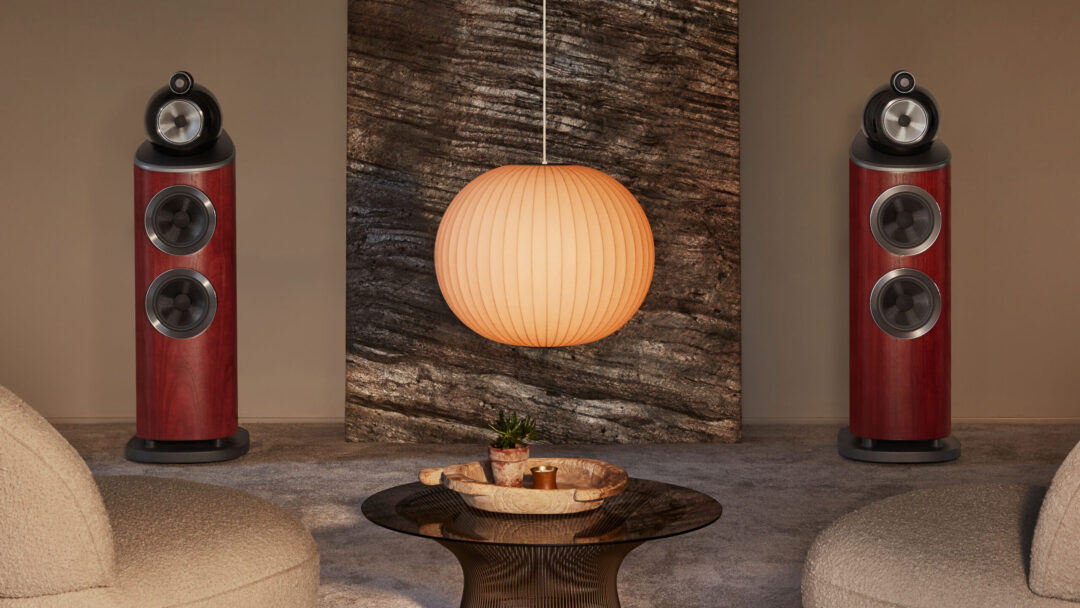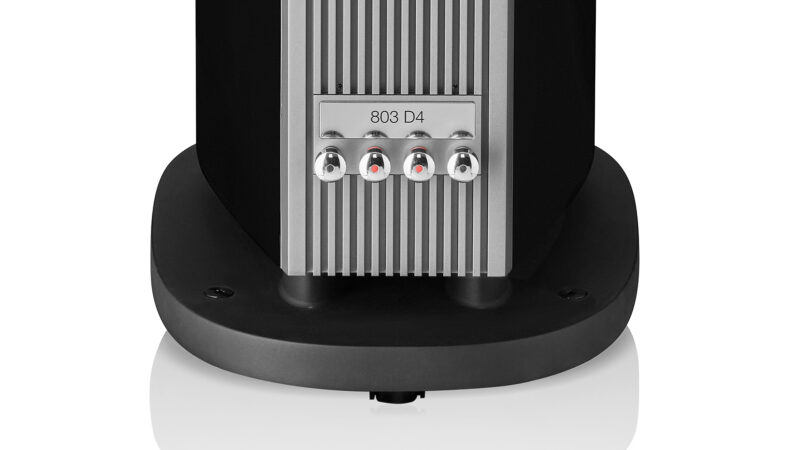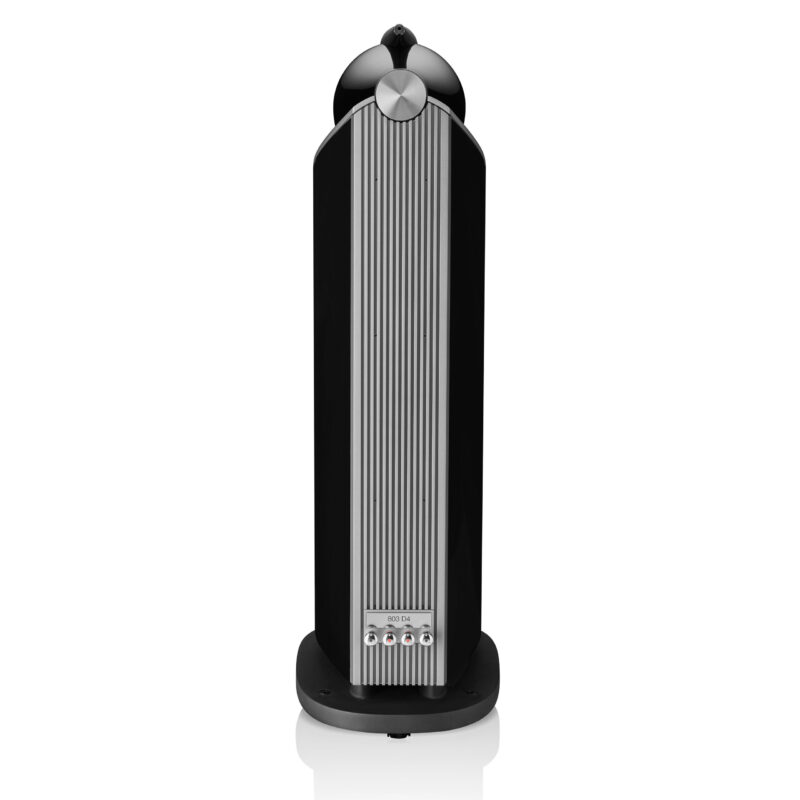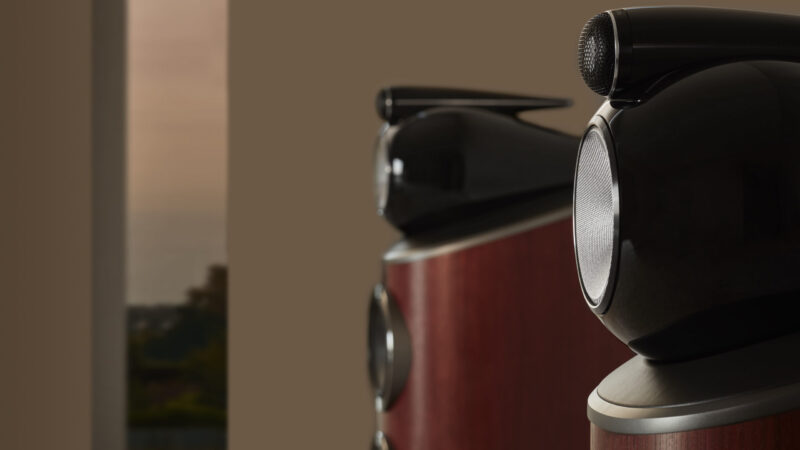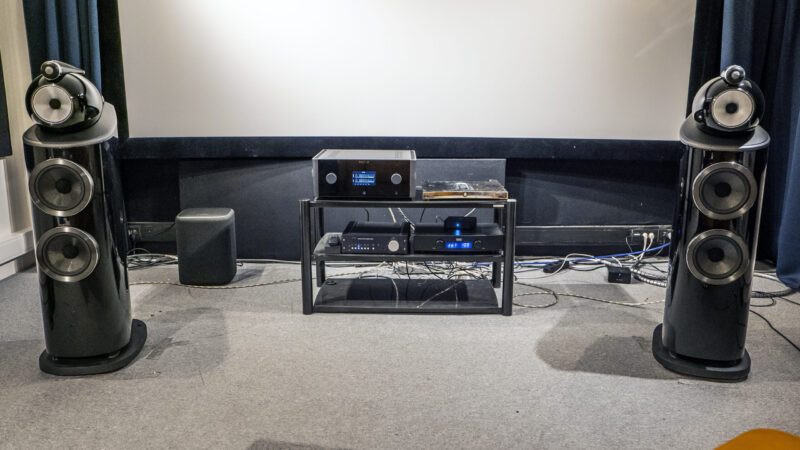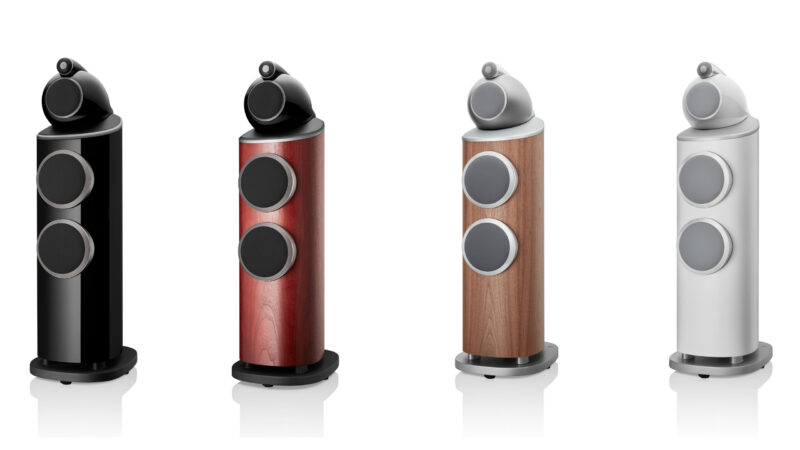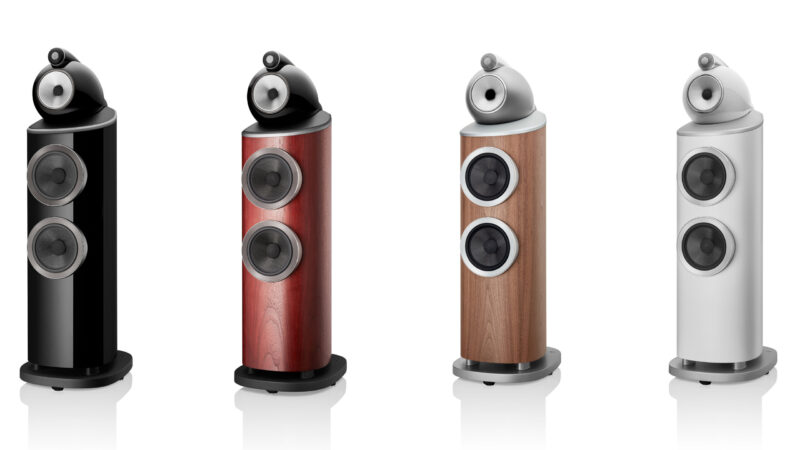Shortly after I got total goose bumps from Bowers & Wilkins’ flagship, the pig-headed and dizzyingly good 801 D4, a pair of the slightly more sensible 803 D4 have entered the test room. But only a little more, because even though the price has almost halved, it’s still possible to buy a new car at this price!
It’s always daunting to test the next best (in this case third best, because there’s also an 802 D4), because you almost get the euphoric feeling you got with the top model, just not quite. And then it’s your business to have to defend a price tag of 22,500 euros knowing that it’s not the best you’ve heard.
Don’t forget, either, that going a little down in size from the top model gives you a pair of speakers that are easier to get into the room thanks to a more manageable low bass. And moving them physically is of course easier too, as the weight is 62 instead of 100 kilos. Each!

Perfect drop shape
The 803 is the smallest and most affordable B&W speaker with its own drop-shaped midrange cabinet (Turbine Head) in addition to the tweeter tube on top. The rest of the cabinet construction is also drop-shaped when viewed from above. This is to direct all sound waves away from each other and thus minimise internal resonances.
The basic shape has been the hallmark of the 800 Series flagship speakers for a number of years. But the shape has been refined and the speaker units, crossover and cabinet design improved over time. All this meticulous work has culminated so far in the D4 series.
The midrange cabinet is made of pure aluminium with highly effective damping and bracing to prevent turbulence and standing sound waves both inside and out.
In the D4 version, the cabinet has even better decoupling from the bass cabinet than before for even cleaner sound. Together with the 13 cm resonance-cancelling Continuum unit, suspended in a so-called Biomimetic Suspension, which reduces unwanted air pressure differences, Bowers & Wilkins promises “the most realistic midrange reproduction ever”.
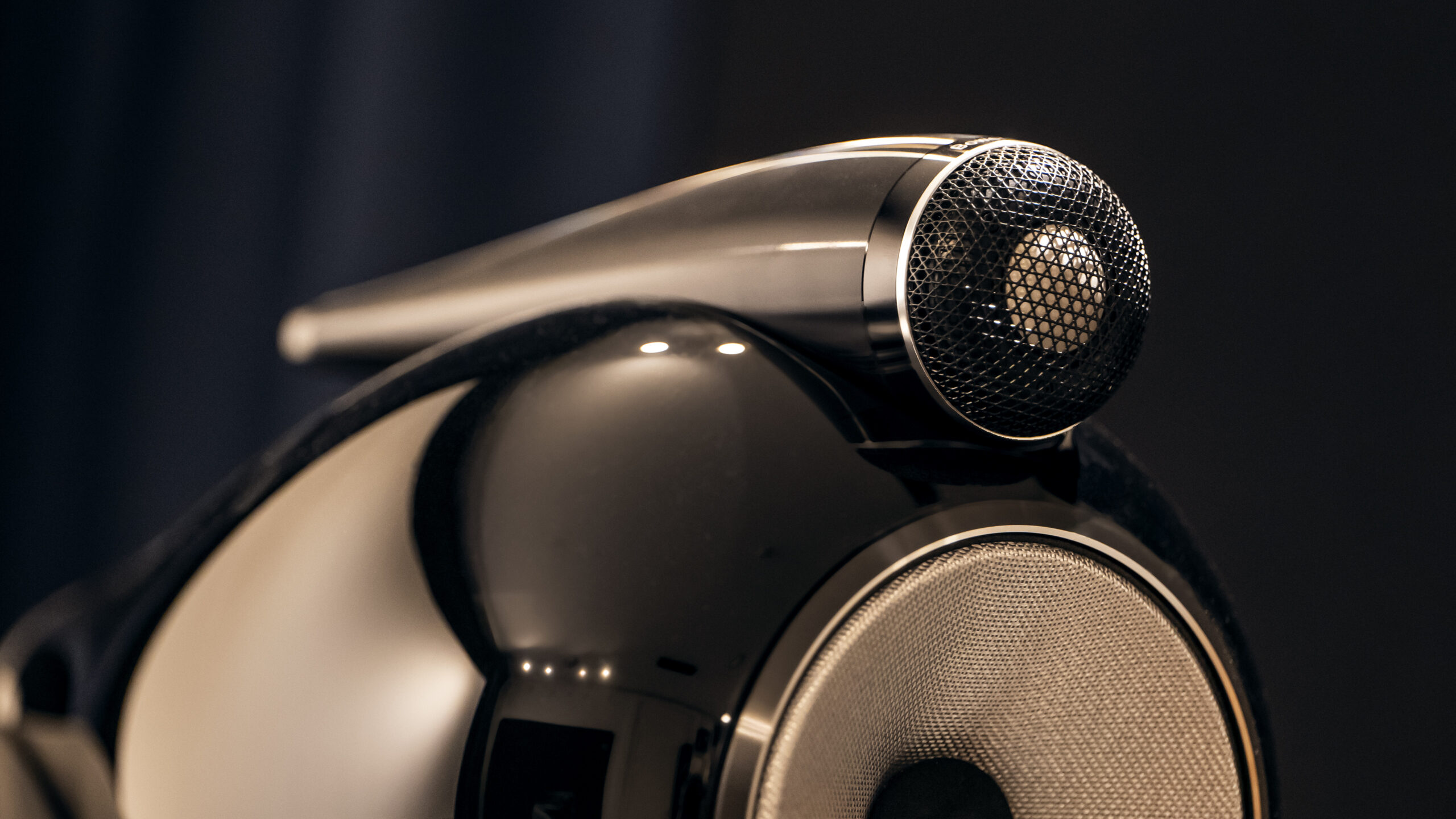
4th generation diamond tweeter
In 2005, the first 800 series with diamond as the diaphragm material for the tweeter dome was introduced. It has the property of being both super-strong and extremely light, enabling a much higher frequency response without breaking up into distortion. Perfect for tweeters, in other words!
The D4 series is the 4th generation of these diamond domes, and over the years both the magnet system and the design in general have undergone important upgrades.
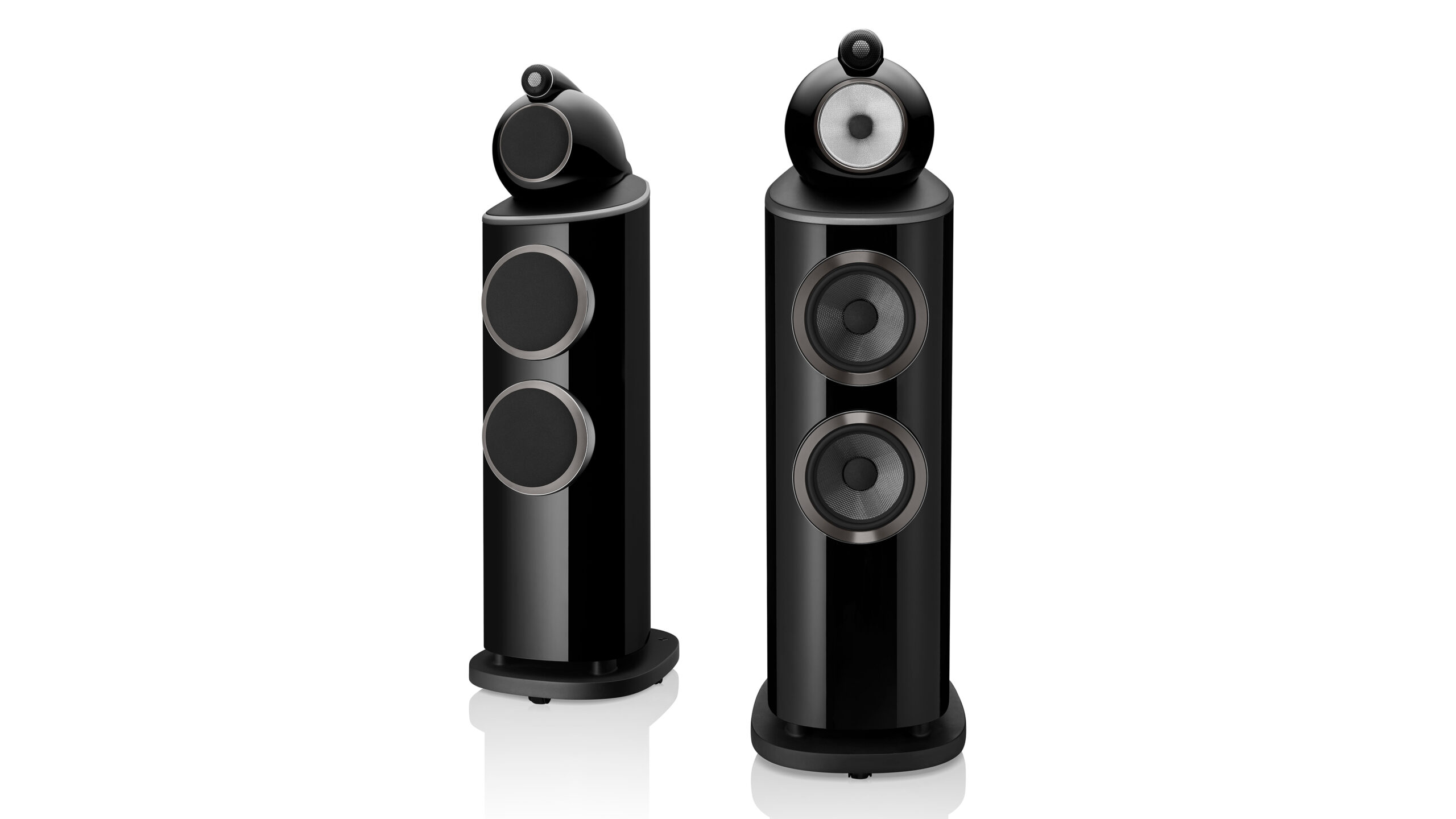
Separate tweeter enclosure
The teardrop-shaped tweeter enclosure on top of the 803 D4 is slightly longer than before to further minimise resonances. A fine-tuning of the equipment in the manufacturing has been necessary, but fortunately not a total replacement like the one needed to build the D3 generation. At the time, some €10 million was invested in machinery alone. The step up from the D2 series was huge, including widespread use of robotics on the production line to perfect the accuracy of the speakers.
Watch the video from Sound & Vision’s factory visit during the production of the B&W 800 D3 series.
Woofers
The 803 D4 is similar in appearance to the larger 802 D4 and the very largest 801 D4, but is slimmer and more flexible. With two 18 cm basses instead of 25 cm on the 801 D4 and 20 cm on the 802 D4.
The woofers of the 803 D4, like those of the other 800 loudspeakers, have cones of composite sandwich construction with carbon fibre outside on a rigid foam material. To get as close as possible to a pure piston motion with minimal breakup along the suspension as the diaphragm moves in and out, the diaphragm is thicker in the center than out at the edges.
If you make a cross-section of the diaphragm and see it in profile, the shape will resemble that of an aeroplane wing. B&W has therefore named the membrane Aerofoil. It first appeared in the 800 D3 series and has impressed us in the past with super clean bass response regardless of sound pressure.
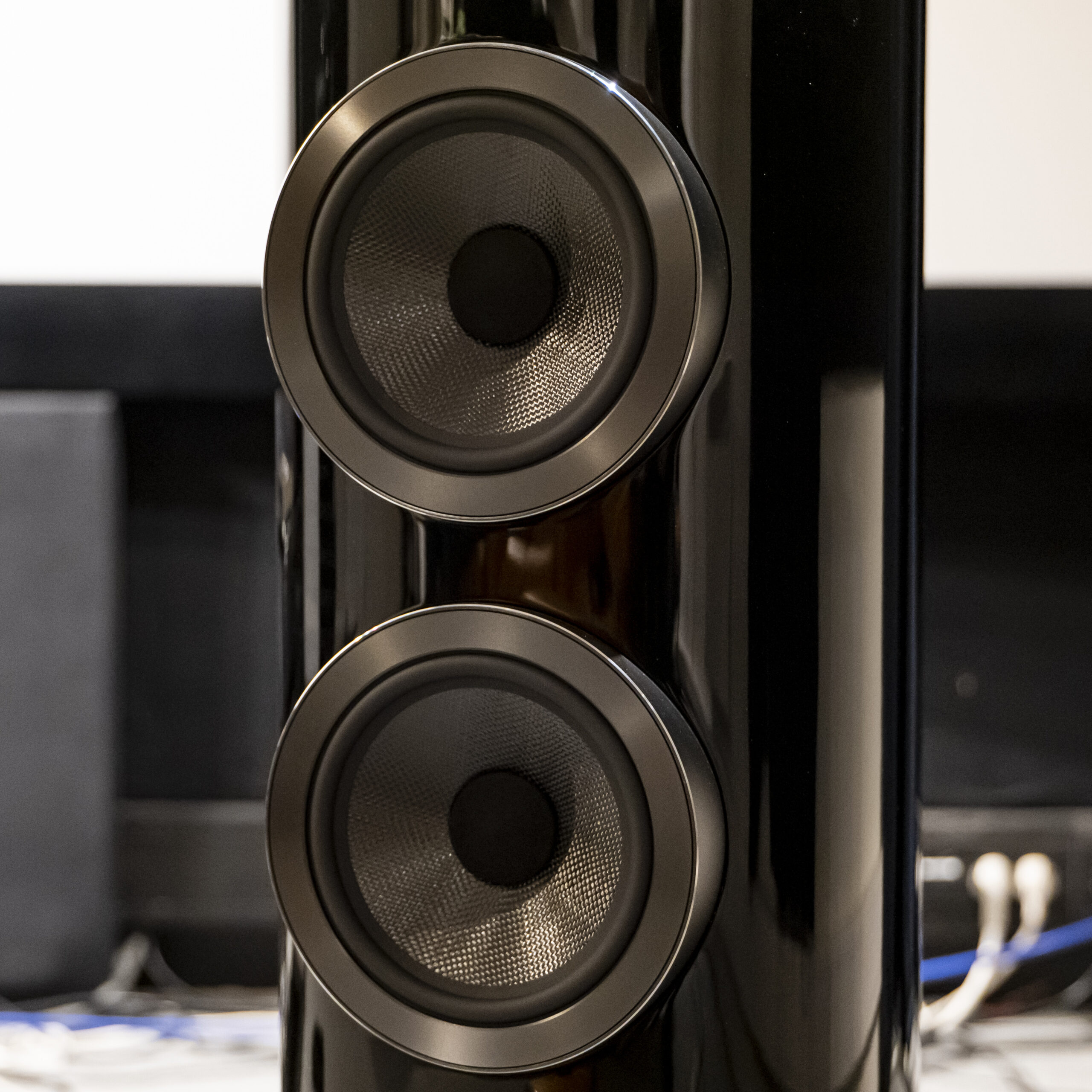
Improved framework
Matrix is the name of B&W’s inner cabinet; the framework on which the outer is built. The latest version uses interwoven panels to reduce resonances by reinforcing the cabinet walls in all directions.
The panels are further reinforced with aluminium at key load points, and the new D4 series simply has to have the best Matrix composition to date. Having experienced the 801 D4, I have no doubt that this is true.
The crossovers
Finally, the crossovers have been upgraded since last time. The capacitors are custom made for B&W by German Mundorf, arguably the world’s best known manufacturer of crossover components. In the 803 D4, as in their siblings, a combination of gold, silver and oil is used to achieve the desired characteristics.
The partial filter is located on the inside of the rear of the loudspeaker, on a large aluminium heat sink. This is to shield against vibration, and it gives the crossover the same temperature almost no matter how much you push the speaker. This should drastically reduce distortion in the crossover components. The design also allows for more space, so the components can be placed further apart to minimize the influence between the electrical fields.
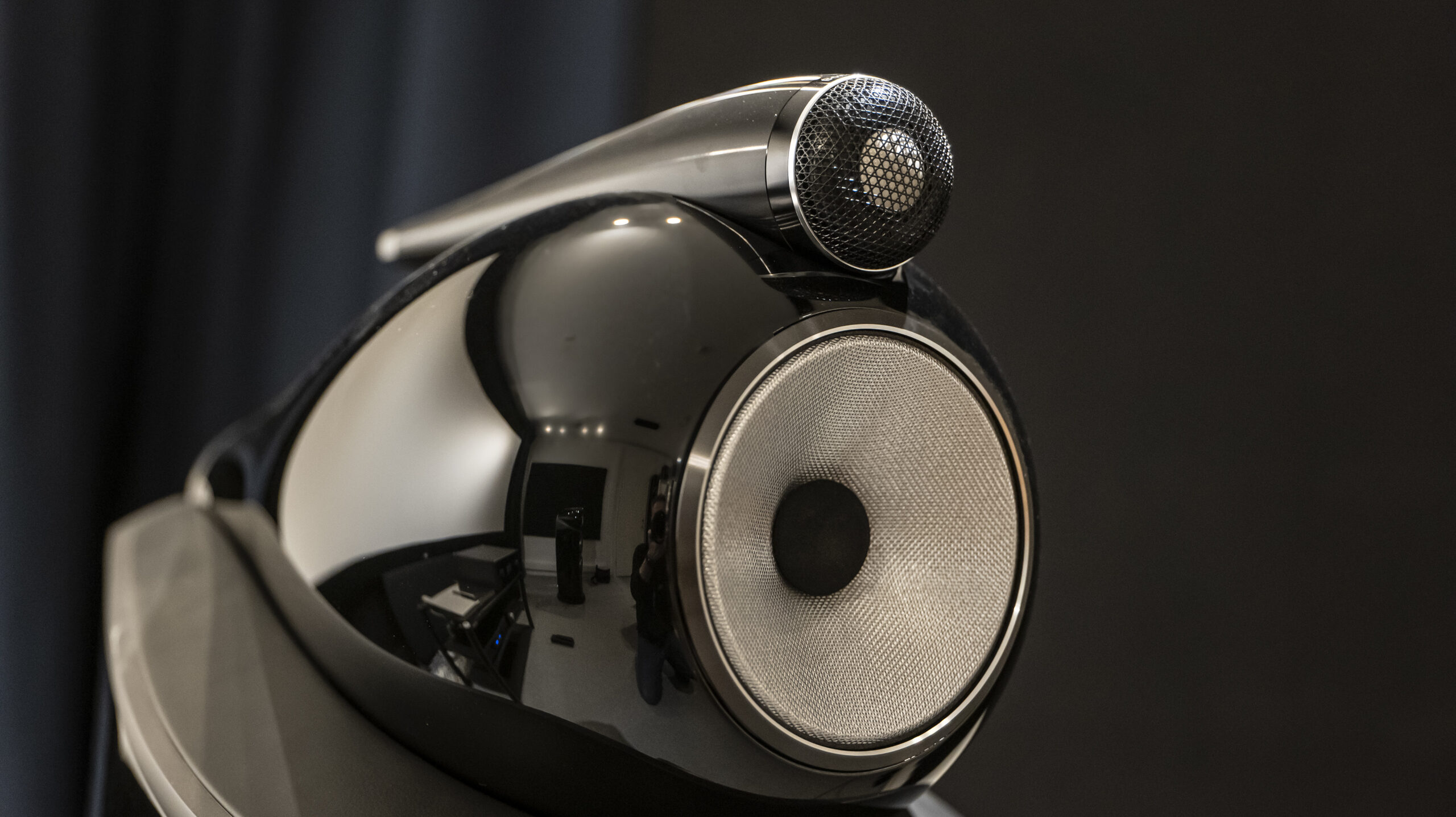
Placement
While it was a two man job to get the largest 801 D4s placed in the test room, the somewhat more compact 803s could be handled just fine single-handedly. With good help from a sack truck. Once the boxes were on the floor of the test room, unpacking the speakers was a breeze.
The packaging is made up of many layers, which can be easily removed, leaving the speaker in the end. A wedge from the box snaps on and forms a ramp on which the speaker can be rolled down.
The speakers can then be rolled into place on the built-in wheels at the bottom. I’d be careful about doing this on a parquet floor, though, for fear of pressure damage. 62 kilos is quite a lot.
Once you’ve found the optimal location, you can remove the magnets covering the studs on the underside of the enclosure and screw them down until they’re planted securely in the floor. Tools for the job are included.
This is ultra high-end that will make you cry. Of joy, of feeling the perfect magic of music. And of sadness, because you can never afford it.
When I tested the 801 D4, I had some real aha moments. Not only with how great they sounded, but also with how much you could tweak them in different directions sonically. In fact, they are so honest and uncolored, and have almost total resolution, so you can really hear the difference between amplifiers and other electronics.
The point is that the 801 D4 can be taken in any direction you want. They’ve got it all!
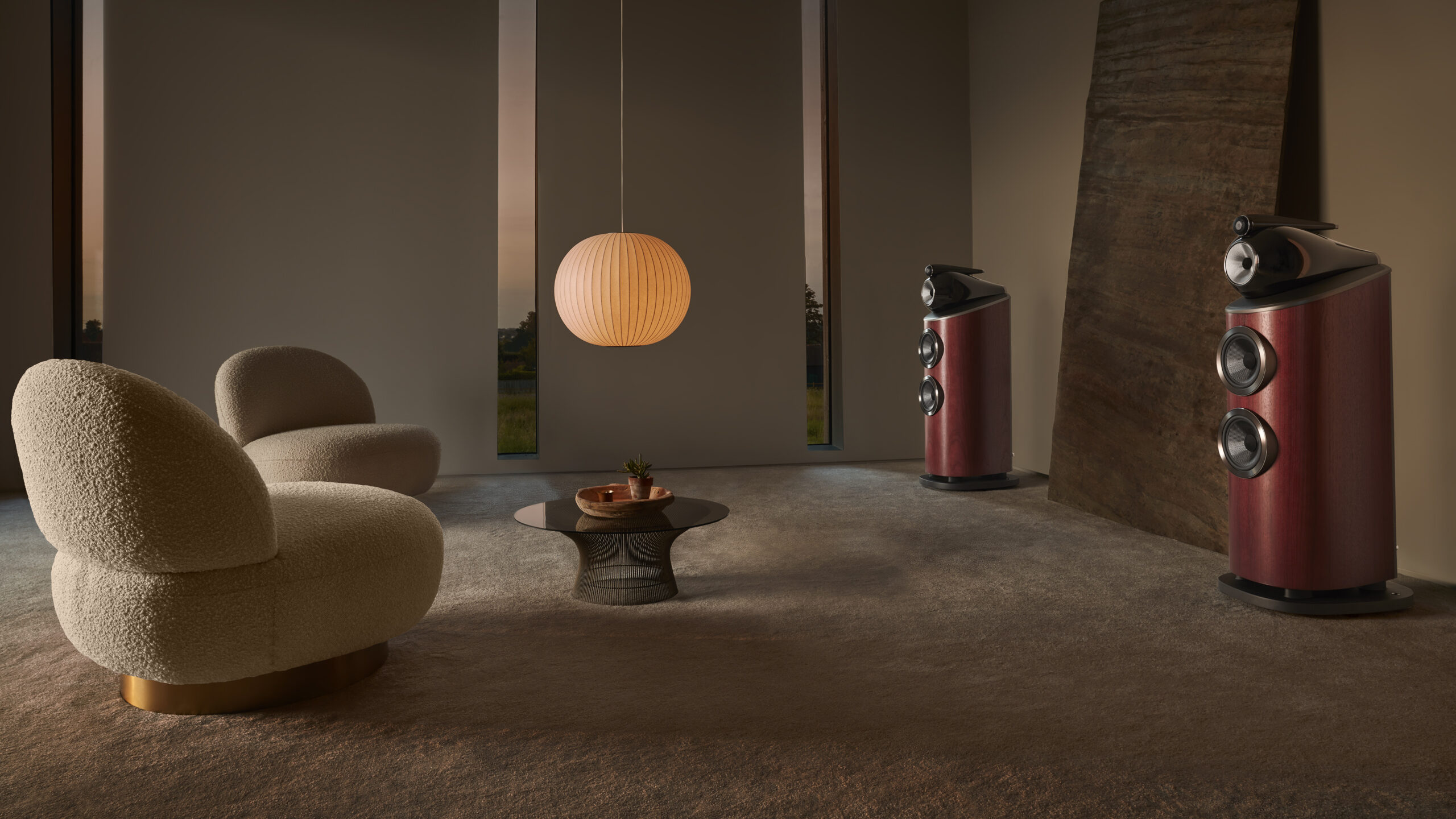
High magic factor
Much of the same can be said about little brother 803 D4. The sound signature – or perhaps more accurately the lack of one – is the same, and with the Devialet amplifier fed music from Roon I get the same sense of magic. Where the hairs on your arms stand up, the corners of your eyes get moist again, and you just want to stay in the test room forever.
John Williams’ Harry’s Wondrous World, familiar from the Harry Potter film series and performed by the Berlin Philharmonic, sounds almost magical in itself, and the speakers have a firm grip on the wand. The winds and strings merge into a gigantic soundscape that fades outwards towards the horizon and also extends far beyond the physical location of the speakers.
High-impact bass
The speakers have a rock-solid bass response, especially when positioned correctly in relation to the walls. Because even though they’re easier to deal with than the biggest 801 D4s, they still go all the way down to 19 Hz with a linearity of -3 dB and only down by 6 dB at 16 Hz. It also helps that they have the same sensitivity of 90 dB and impedance of 3-8 ohms as their big brothers, which means you can use the same amplifier on both of them.
The double bass on Esperanza Spalding’s “Formwela 10” sounds formidable, with a delicious clang from the strings against the fretless fingerboard. The bass range is experienced as slightly rounder than with the 801 D4. Not woolly at all, but somewhat softer, I imagine.
What I do notice is that although the bass goes very deep and forms a solid foundation, it’s not as thunderously percussive as from the 10-inches of big brother 801 D4. Not even when playing at sensible volume levels.
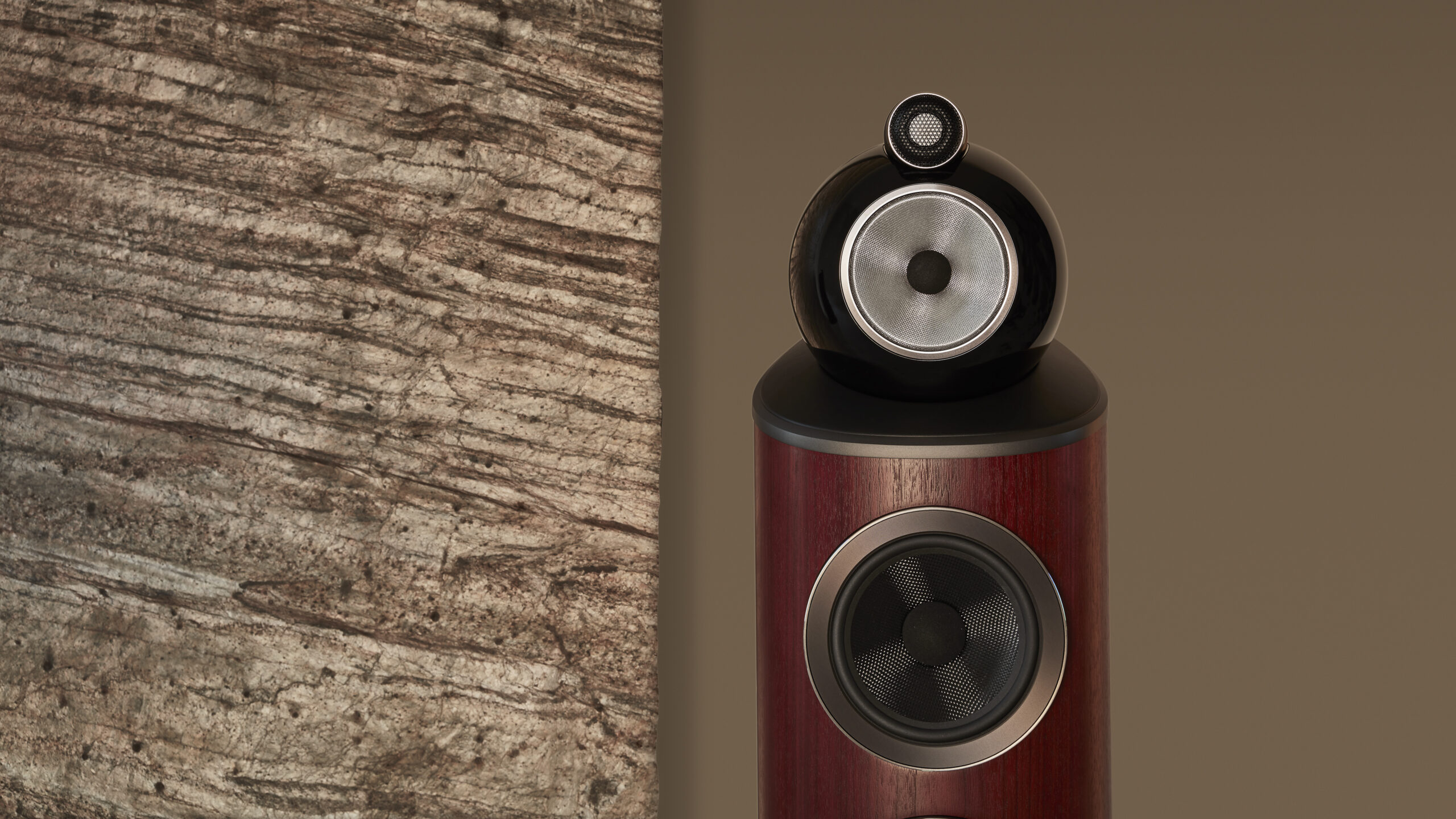
Amplifier change
It helps to switch to the aforementioned Michi X5 with 2 x 350 watts into 8 ohms. Here the speakers really get moving, and Halsey’s “People Disappear Here”, produced by Trent Reznor of Nine Inch Nails, hits the spot. The bass is hard and punchy, and although the energy at the bottom rolls off a little higher than on the big brothers, it sounds really cool.
Much better than its predecessor
My biggest gripe with the predecessor 803 D3 was that it was a little cautious. Especially in the bass, which never got quite physical enough for my taste, considering how much the speakers take up in the living room.
Here the D4 version is much better, and the dynamics of the bass are quite different. Throughout the frequency range. The new version sounds more alive, more immersive and much more entertaining. Voices stand out as if they were cut out of the air with a laser. No distortion or coloration here, just good sound. Wonderful!
Even cooler with a subwoofer?
It should also be mentioned that the extra that the 801 D4 offers in terms of format, foundation and fabulousness, you pay quite a lot for. For example, you can afford a pair of high-end B&W DB2D subwoofers in addition to the 803 D4 and still have money to spare compared to what you’d pay for the 801 D4. I dare not think how much the little brother together with two subs would shake the big brother!
The advantage of the 803 D4 is exactly that they are so linear and neutral that you can use them as they are, but they are also a great starting point for a subwoofer. With a seamless transition where the two aren’t battling in the same frequency range. Hearing the 803 D4 with a subwoofer – or two – is definitely on my wish list.
Competition
The 803 D4 is in a price bracket where you can find a lot of other good stuff. For example, the Vivid Audio Kaya 90, which actually uses much the same acoustic principles as B&W’s 800 series, and also has vanishingly low distortion. If anything, the Kaya 90 is even more spacious in the midrange, with an even more refined centre to the soundstage. But at the same time they don’t have the same depth bass to go with it.
The KEF Reference 5 Meta is a highly regarded candidate that should definitely be heard. About the same weight as the 803 D4, but with a more standardised and square appearance. The KEF speakers attack you physically with every drum beat and have a more energetic and aggressive playing style, but still super focused and with distinguished resolution. Nor do they have quite the same deep bass as the B&Ws, but physics is something they really can do.
Let’s not forget the Audiovector R6 Arreté either. Also fantastic and with many of the same qualities as the B&Ws, just in a slightly different way. For example, they don’t need as much power to come to life. But the 803 D4 are even more homogeneous.
The Dynaudio Confidence 50 is also a speaker that’s easy to like, and it does everything right. But it really needs a lot of amplifier power and perhaps even more space to get it right.
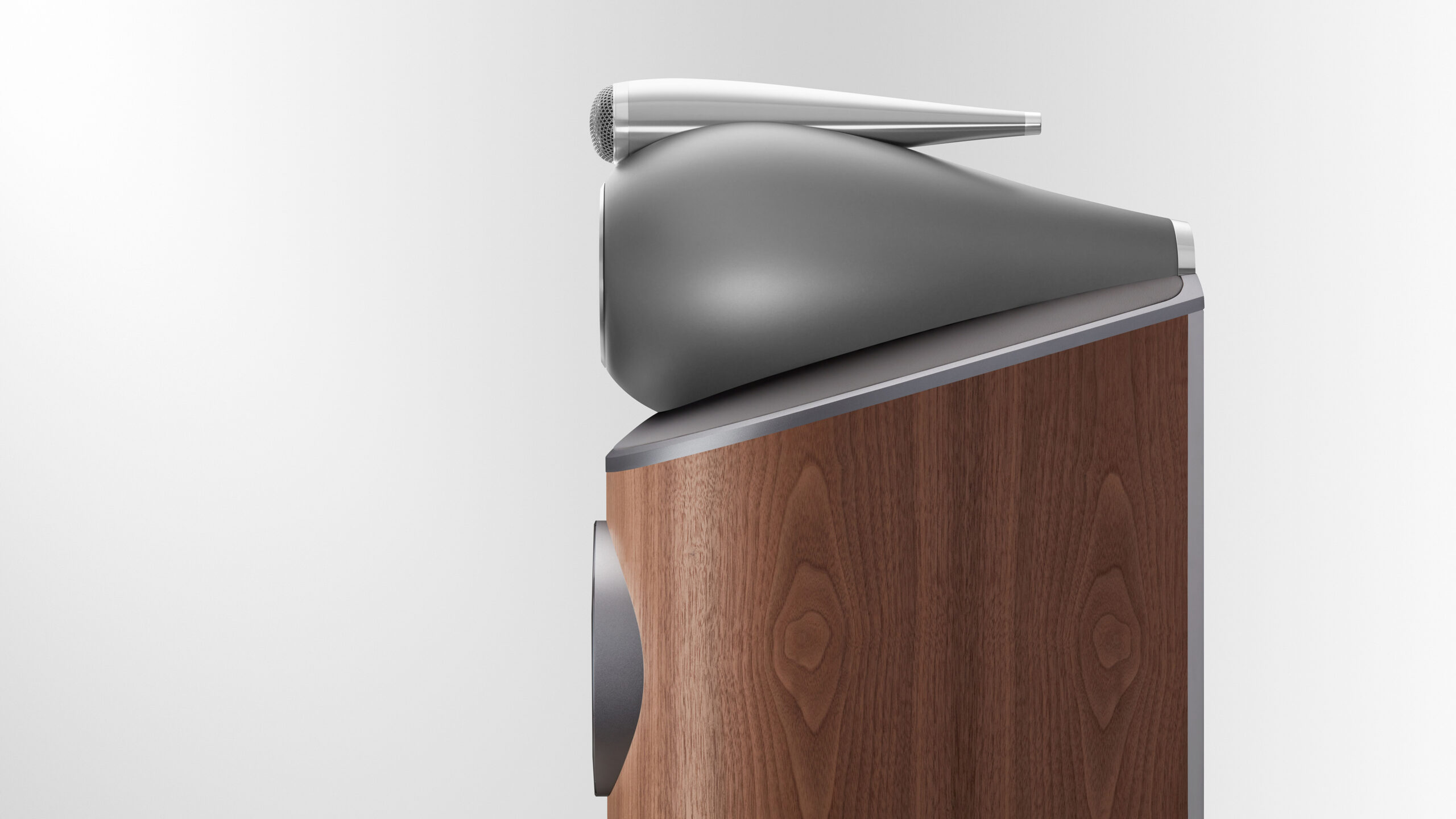
Conclusion
After hearing Bowers & Wilkins’ flagship 801 D4 recently, I feared that the little brother 803 D4 would be a bit of a letdown. But I was wrong, because the experience of sound and music is very much the same here. Especially on vocals and acoustic instruments, you can hear how focused and dynamic – and not least airy – everything sounds.
The bass isn’t quite as brutal, but it’s unleashed to a greater extent than on its predecessor, and it can be very brutal when the speakers are given enough power to work with. The tones are deep and delicious, and you’re left with the feeling that you’ve experienced a complete pair of speakers. In every way.
The price is increased with the D4 series, but so is the sound quality. It’s masterful!

We think
Great sound! Great ambience and especially great presence and resolution in the voice register. The music comes alive to a degree we have rarely heard. The impact is somewhat reduced in the very deepest bass.
22500 €
Specifications
- Type: 3-way bass reflex
- Woofer: 2 x 18 cm (7″) Aerofoil
- Midrange: 13 cm (5″) Biomimetic Suspension Continuum FST
- Tweeter: 2.5 cm (1″) diamond
- Sensitivity: 90 dB (2.83 V, 1 m)
- Impedance: 8 ohms (min. 3 ohms)
- Frequency range: 19 Hz – 28 kHz (-3 dB) / 16 Hz – 35 kHz (-6 dB)
- Crossover frequency: (not specified)
- Max. power: 500 W
- Recommended amplifier power: 50-500 W
- Dimensions and weight: 116.5 x 35.7 x 51.1 cm / 62.15 kg
- Finish: High gloss black, white, rosewood, walnut
- Web: bowerswilkins.com
